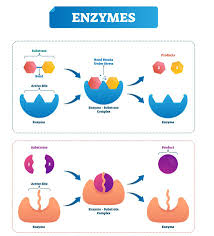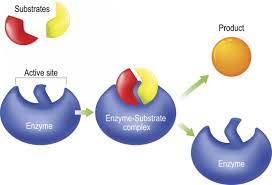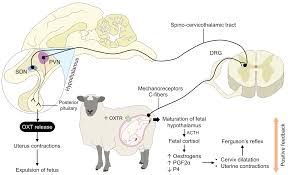The roles of enzymes and hormones in life cannot be overemphasized. There is no anabolic or catabolic reaction in living organisms that is not mediated by an enzyme or prompted by a hormone.
The listing of enzymes and hormones is inexhaustible, and the roles played by many have not even been discovered. In agricultural science, enzymes and hormones play crucial roles in plant growth, soil fertility, and animal metabolism.
Definition of Enzymes
Enzymes are naturally occurring macromolecular substances composed wholly or largely of proteins that catalyze one or more biochemical reactions at relatively low temperatures.
Enzymes are often easily inactivated by heating or by protein-denaturing agents. The substances on which they act are known as substrates, and each enzyme possesses a specific binding or active site.
Nature of Enzymes

Many enzymes require a specific, heat-stable, low molecular weight organic molecule, a coenzyme, to enhance their activity. Reactions that require coenzymes include oxido-reductions, lyase and isomerization reactions, and reactions that form covalent bonds (IUB classes 1, 2, 5, and 6).
For example, in the oxidation of pyruvate, the hydrogen released must be removed. This is done by nicotinamide-adenine dinucleotide (NAD) or nicotinamide-adenine dinucleotide phosphate (NADP). In this illustration, NAD and NADP function as coenzymes.
Another example is cytochromes, which are proteins important in oxidation reactions. They accept electrons from a reduced substance, which is consequently oxidized. Without the iron-containing haem group, the enzyme becomes inactive, as electron exchange takes place at the iron atom.
Active groups such as these are known as prosthetic groups when they are part of the enzyme molecule. The remainder of the molecule is called the apoenzyme, and the whole molecule is known as the holoenzyme.
Thus, the holoenzyme is a catalytically active complex comprising the protein part (apoenzyme) combined with the appropriate coenzymes or cofactors.
Specific Nature of Enzymes
Enzyme specificity is classified as follows:
1. Absolute Specificity: An enzyme catalyzes the reaction of a single substrate only. Example: Urease catalyzes only the breakdown of urea into ammonia and carbon dioxide.
2. Relative Specificity: An enzyme reacts with a number of substrates. Example: Esterases catalyze several reactions involving esters.
Specificity may arise from the need for spatial conjunction of the active groups of the substrate with the active center of the enzyme. The lock and key model suggests that the molecular geometry of both enzyme and substrate must allow for a precise fit.
The induced fit model suggests that the enzyme changes shape in response to the presence of the substrate, allowing the formation of the enzyme-substrate complex.
Factors Affecting Enzyme Activity

Several factors influence enzyme activity, including:
1. Substrate Concentration: When enzyme concentration remains constant, an increase in substrate concentration increases reaction velocity until a saturation point is reached.
2. Enzyme Concentration: In a system where the substrate is in excess, an increase in enzyme concentration may have limitations, as enzymes are rarely saturated with substrates under physiological conditions.
3. Inhibitors: Some substances inhibit enzyme activity by preventing enzyme-substrate complex formation. This can be:
i. Competitive inhibition: The inhibitor competes with the substrate for the active site.
ii. Uncompetitive inhibition: The inhibitor binds to the enzyme-substrate complex, preventing product formation.
iii. Non-competitive inhibition: The inhibitor binds to a site other than the active site, altering the enzyme’s structure.
iv. Irreversible inactivation: The inhibitor permanently deactivates the enzyme.
4. Temperature: Each enzyme has an optimal temperature range. Extreme heat can cause denaturation, leading to enzyme inactivation.
5. pH: Enzymes function best within a specific pH range, usually around pH 6-7 in cells. Extreme acidity or alkalinity can cause denaturation and loss of activity.
Nomenclature and Classification of Enzymes
Enzymes were initially named by adding the suffix -ase to the name of the substrate they acted upon. Later, enzymes were categorized based on the type of chemical reaction they catalyze. The International Union of Biochemistry (IUB) classified enzymes into six major classes:
1. Oxidoreductases: Catalyze oxidation and reduction reactions.
2. Transferases: Catalyze the transfer of a functional group from one molecule to another.
3. Hydrolases: Catalyze bond cleavage by the introduction of water molecules.
4. Lyases: Catalyze the removal or addition of a group to form a double bond.
5. Isomerases: Catalyze intermolecular rearrangements.
6. Ligases (Synthases): Catalyze reactions that join two molecules.
Each enzyme has a code number (EC) representing its class, subclass, sub-subclass, and specific enzyme designation.
Read Also: How to Raise Ruminant Animals for Fattening and Reproduction together
Definition of Hormones

A hormone is a substance synthesized in one tissue and transported by the circulatory system to act on another organ. Hormones can also act on adjacent cells or be secreted directly into the blood, lymph, or intercellular fluids.
A hormone may target a single tissue or affect multiple tissues. The response of a target tissue to a hormone depends on:
1. The local concentration of the hormone, which is influenced by:
i. The rate of hormone synthesis and secretion.
ii. The proximity of the target to the source.
iii. The hormone’s interaction with carrier proteins in the plasma.
iv. The conversion of an inactive or optimally active form of the hormone into the active form.
v. The rate of hormone clearance through degradation or excretion.
2. The actual response of the target tissue, which depends on:
i. The number and state of occupancy of specific hormone receptors.
ii.The post-receptor sensitization or desensitization of the cell.
Hormone Action
The principle of endocrine action can be illustrated using the thyroid gland as an example. The thyroid gland secretes hormones that regulate metabolism, and its activity is controlled by negative feedback mechanisms.
Understanding enzymes and hormones is crucial in agriculture, as they influence plant growth, livestock metabolism, and soil health. Proper knowledge of these biological molecules helps in improving agricultural productivity and sustainability.
Thyroxine
1. Increased Basal Metabolic Rate
The thyroid gland secretes thyroxine, a complex organic compound containing iodine. Thyroxine controls the basal metabolic rate and plays a vital role in growth regulation. Its release into the bloodstream is triggered by a hormone secreted by the anterior lobe of the pituitary gland, called thyroid-stimulating hormone (TSH) or thyrotrophic hormone.
Thyroxine regulates its own production through a negative feedback mechanism. A slight excess of thyroxine in the bloodstream inhibits the pituitary gland from secreting TSH, reducing thyroid activity and decreasing thyroxine production.
When thyroxine levels drop, the inhibition is removed, prompting the pituitary gland to produce more TSH, thereby increasing thyroxine production. This cycle exemplifies the principles of hormone action.
2. Hormonal Control Mechanisms
Different types of endocrine control systems regulate hormone secretion. One of the simplest systems involves a hormone acting on specific cells, promoting changes in the extracellular fluid, which in turn regulates hormone output by the gland.
This negative feedback system can be influenced by endocrine and neural actions affecting either the gland itself or the hormonally responsive effector cells. Examples include insulin, parathyroid hormone (PTH), and aldosterone, which operate independently of direct hypothalamic or pituitary control.
3. Example of a Hormonal Control System
A hormonogen (hormone precursor) is secreted into the bloodstream by one organ and converted into an active hormone through enzymatic action from another organ. The resulting hormone stimulates a target organ, triggering a response that decreases enzyme production. An example is angiotensinogen (hormonogen), which is converted into angiotensin and then into aldosterone.
In some cases, the hormonogen is derived from the diet or synthesized within the body and undergoes successive transformations in multiple organs before becoming biologically active. An example is the conversion of cholecalciferol to 25-hydroxycholecalciferol and then to 1,25-dihydroxycholecalciferol.
Another control system involves endocrine gland activity being regulated by the hypothalamus. For example, the secretion of growth hormone by the anterior pituitary and vasopressin by the posterior pituitary is controlled by hypothalamic function. In this system, feedback regulation is exerted on the hypothalamus, which in turn controls gland function. Plasma constituents act as feedback effectors in this process.
Read Also: Fattening Ruminants? Find out the Best Sex to Raise
Classification of Hormones

Hormones can be classified based on:
- Chemical Composition
- Solubility Properties
- Location of Receptors
- Site of Production
- Nature of the Signal Used to Mediate Hormone Action
For this article, hormones are categorized based on their site of production:
i. Hormones of the Pituitary and Hypothalamus
ii. Thyroid Hormones
iii. Hormones of Calcium Metabolism
iv. Hormones of the Adrenal Cortex
v. Hormones of the Adrenal Medulla
vi. Hormones of the Gonads
vii. Hormones of the Pancreas and Gastrointestinal Tract
1. Hormones of the Pituitary and Hypothalamus: The anterior pituitary, under hypothalamic control, secretes several trophic hormones that regulate endocrine glands or metabolic processes. The posterior pituitary releases hormones that regulate water balance and milk letdown.
2. Hypothalamic Hormones:
| Hormone | Acronym | Function |
|---|---|---|
| Corticotropin-releasing factor | CRF/CRH | Stimulates ACTH and β-endorphin secretion |
| Gonadotropin-releasing factor | GnRF/GnRH | Stimulates LH and FSH secretion |
| Prolactin-releasing factor | PRF | Stimulates prolactin secretion |
| Prolactin-release inhibiting factor | PIF | Inhibits prolactin secretion |
| Growth hormone-releasing factor | GRH/GRF | Stimulates GH secretion |
| Somatostatin (Growth hormone release-inhibiting factor) | SIF | Inhibits GH and TSH secretion |
| Thyrotropin-releasing factor | TRF/TRH | Stimulates TSH and prolactin secretion |
3. Pituitary Hormones:
| Hormone | Acronym | Function |
|---|---|---|
| Oxytocin | Uterine contraction, milk ejection | |
| Vasopressin (Antidiuretic hormone) | ADH | Regulates blood pressure and water balance |
| Melanocyte-stimulating hormone | MSH | Regulates pigmentation |
| Lipotropin | LPH | Promotes fatty acid release |
| Adrenocorticotropic hormone | ACTH | Stimulates adrenal steroid synthesis |
| Thyroid-stimulating hormone | TSH | Stimulates thyroid hormone synthesis |
| Growth Hormone (Somatotropin) | GH | Promotes anabolic effects and IGF-I release |
| Prolactin | Stimulates milk synthesis | |
| Luteinizing hormone | LH | Regulates ovarian luteinization and progesterone synthesis; stimulates testosterone production in testes |
| Follicle-stimulating hormone | FSH | Regulates follicle development, ovulation, and estrogen synthesis in ovaries; promotes spermatogenesis in testes |
4. Thyroid Hormones: Thyroid hormones regulate gene expression, tissue differentiation, and general development. The thyroid gland produces:
i. Triiodothyronine (T3): Stimulates many cellular reactions.
ii.Thyroxine (T4): Stimulates metabolic processes.
iii. Calcitonin: Regulates calcium and phosphate metabolism.
5. Hormones of the Adrenal Cortex: The adrenal cortex produces steroid hormones categorized into:
i. Glucocorticoids (Cortisol, Corticosterone): Essential for adaptation to stress.
ii. Mineralocorticoids (Aldosterone): Maintains sodium and potassium balance.
iii. Androgens: Includes precursors like dehydroepiandrosterone and androstenedione.
6. Hormones of the Adrenal Medulla: The adrenal medulla functions as an endocrine organ, releasing catecholamines:
i. Dopamine: Involved in stress response.
ii. Norepinephrine (Noradrenaline): Causes arteriolar contraction and lipid release.
iii. Epinephrine (Adrenaline): Regulates smooth muscle contraction, heart function, glycogenolysis, and lipid release.
7. Hormones of the Gonads:
i. Ovarian Hormones:
ii. Estrogens (Estradiol, Estrone): Regulate secondary sex organs and mammary gland development.
iii. Progestins (Progesterone): Maintain pregnancy and mammary gland function.
iv. Testicular Hormones:
v. Testosterone: Regulates secondary sex organ maturation and function.
vi. Inhibins A and B: Inhibit FSH secretion.
8. Hormones of the Pancreas and Gastrointestinal Tract: The pancreas has both exocrine and endocrine functions. The endocrine portion, the Islets of Langerhans, secretes:
i. Insulin: Lowers blood glucose.
ii. Glucagon: Increases blood glucose.
iii. Pancreatic polypeptide (PP): Regulates pancreatic enzyme secretion.
iv. Somatostatin: Inhibits glucagon and gastrin secretion.
Gastrointestinal hormones regulate digestion and motility, including gastrin, secretin, cholecystokinin, motilin, and vasoactive intestinal peptide (VIP).
Enzymes and hormones, though produced in small quantities, are essential for life. Unlike vitamins, deficiencies cannot be corrected through diet. Hormones coordinate cellular activities, and their regulation often follows a negative feedback mechanism, as seen in the control of thyroxine secretion.
Do you have any questions, suggestions, or contributions? If so, please feel free to use the comment box below to share your thoughts. We also encourage you to kindly share this information with others who might benefit from it. Since we can’t reach everyone at once, we truly appreciate your help in spreading the word. Thank you so much for your support and for sharing!

